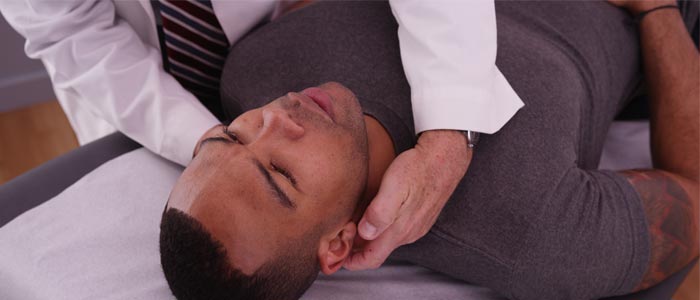How to Avoid Neck Pain & Injury From Exercising
10th Dec 19

Exercise, at its core, is all about making you a happier, healthier person and making sure you’re doing good for your body. However, exercising comes with a risk of pain and injury, especially in places like your neck. It shouldn’t happen, but sadly, that’s not how the world works. Exercise is an incredibly complex subject, and there are more mistakes that you could be making than you probably realise. The result is that from bad technique, overloading weights or simply freak accidents, you can land yourself some pretty awful neck pains and injuries. Even worse still, most of the time, it’s avoidable.
We’re here with some of the most common nack aches, pains and injuries in exercise and rooting out their causes so that they don’t happen to you. Knowledge is power, and when it comes to injury prevention, you just can’t be too careful. Let’s dive in.
Want to move fast? Jump to the right section below.
- Avoid Repetitive Strain & Overload
- Warm Up & Cool Down
- Use Proper Form
- Avoid Dangerous Exercises
- Therapy
Avoid Repetitive Strain & Overload

One of the most common causes of neck pain or injury from exercising comes from repetitive strain. This is mostly because of the wear and tear that comes from exercising the same muscles frequently but often not in the right way or with bad form. As a result, your neck has to compensate for some muscles that aren’t engaging in the way they should.
The easiest way for it to happen is when you’re lifting weight above your head. Shoulder pressing, for example, with too much weight. When it’s up, your neck tenses and moves to support the new centre of balance, even without you noticing. Doing this repeatedly is what causes repetitive strain and even potentially long-term damage. Of course, your form is everything, but we’ll get onto that soon.
Warm Up & Cool Down
Another fundamental way to avoid neck pain and injury from exercise is to always warm up before you begin. Make sure the muscle groups you’re about to use are prepared for the workload they are about to experience. If not, you are far more likely to do damage.
Generally speaking, the best way to do this is to do a cardio exercise for around 5 minutes before any exercise to get the blood flowing to the muscles you’re going to use. Then, after that, performing a warm-up set with around 40% of your intended weight is golden too.
This doesn’t stop at pre-exercise, either. Cooling down after you have finished can also greatly benefit your muscles by gradually reducing the blood flow to a resting rate and stretching the muscles back to their original state. That even helps reduce soreness the next day (see DOMS) and is generally better for short-term and long-term muscle health.
Use Proper Form

This tends to go without saying, but as mentioned above, the likely cause of your neck pain and even a neck injury is bad form in at least one exercise. Another of the strongest ways to avoid injury is to make sure your form is as good as it can be. It’s more important than people realise.
Do your research to find out what are the common mistakes or ask people to point them out for you when you are performing the exercise yourself. Then, make sure you can actively think about what it is you need to be avoiding whilst you’re still exercising. That’s the only to really prevent an injury.
This is sometimes easier if you are exercising in front of a mirror or with a partner. It enables you to actually see what you’re doing and where your errors are. Without either, you may find yourself making mistakes without even knowing or even being confident that you aren’t.
Avoid Dangerous Exercises
Another great way to avoid neck pain and neck injury is by avoiding some of the most renowned exercises for causing them. Exercises like the behind-the-neck shoulder press or the upright row, for example. They can easily damage not only the shoulders but the neck too. The two put too much pressure on your neck for balance or stability and can even cause impact damage by hitting your neck with equipment like a barbell if you fail a rep or lose your technique during the exercise.
Most exercises that involve weight behind the neck will be detrimental to your health, so try and keep the weight in front of you for most exercises. Of course, that’s not a rule, but unless you really do know what you’re doing, it’s sound advice.
Therapy

Long-term upkeep of all of your muscles is a good idea, but for areas like your neck, back and legs in particular, where you can sustain damage to your entire body, it can even be advisable to seek physical treatments for your muscles after workouts or on rest days, such as with sports massages. Spending time in areas like hydro pools is another great one too. Essentially forcing your muscles to relax and encouraging healthy growth is rarely a bad thing.
It’s also a good idea to perform neck-specific stretches to really help the healing process and prevent another injury. (Here’s an article from WebMD for more).
Even if you begin to notice slight discomfort in the neck region or perhaps something begins to click or crack, it could well be a good idea to consult a medical professional about the issue. You’ll only then receive the best advice and possibly even undergo a correction exercise regime to prevent any long-term damage, or see a physiotherapist.
The neck is an extremely dangerous place to get an injury. Make sure you know what you’re doing when you’re exercising in a way that may put it at risk. You just can’t be too careful.

Before beginning any exercise or nutrition program, consult your physician, doctor or other professional. This is especially important for individuals over the age of 35 or persons with pre-existing health problems. Exercise.co.uk assumes no responsibility for personal injury or property damage sustained using our advice.
If you experience dizziness, nausea, chest pain, or any other abnormal symptoms, stop the workout at once and consult a physician or doctor immediately.









